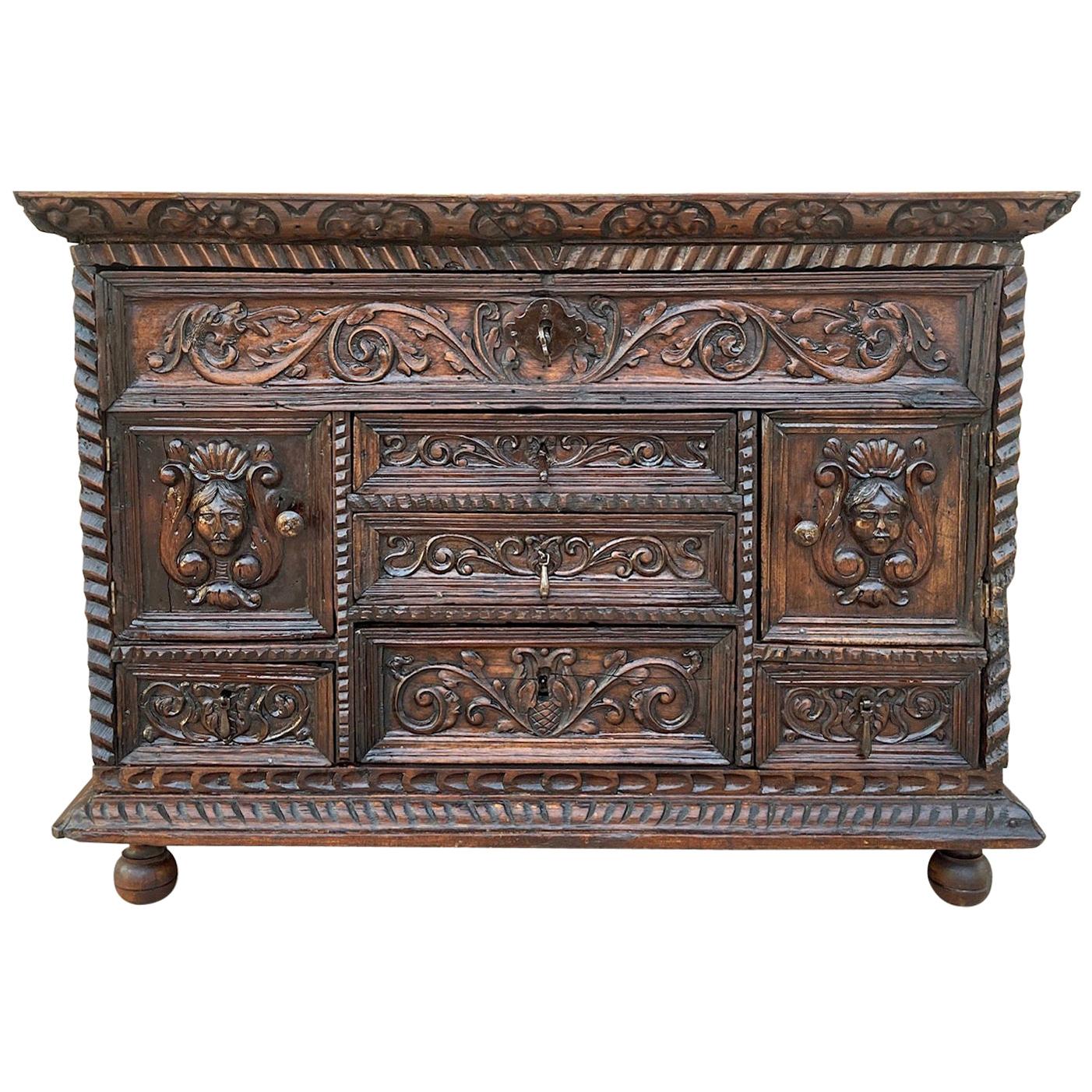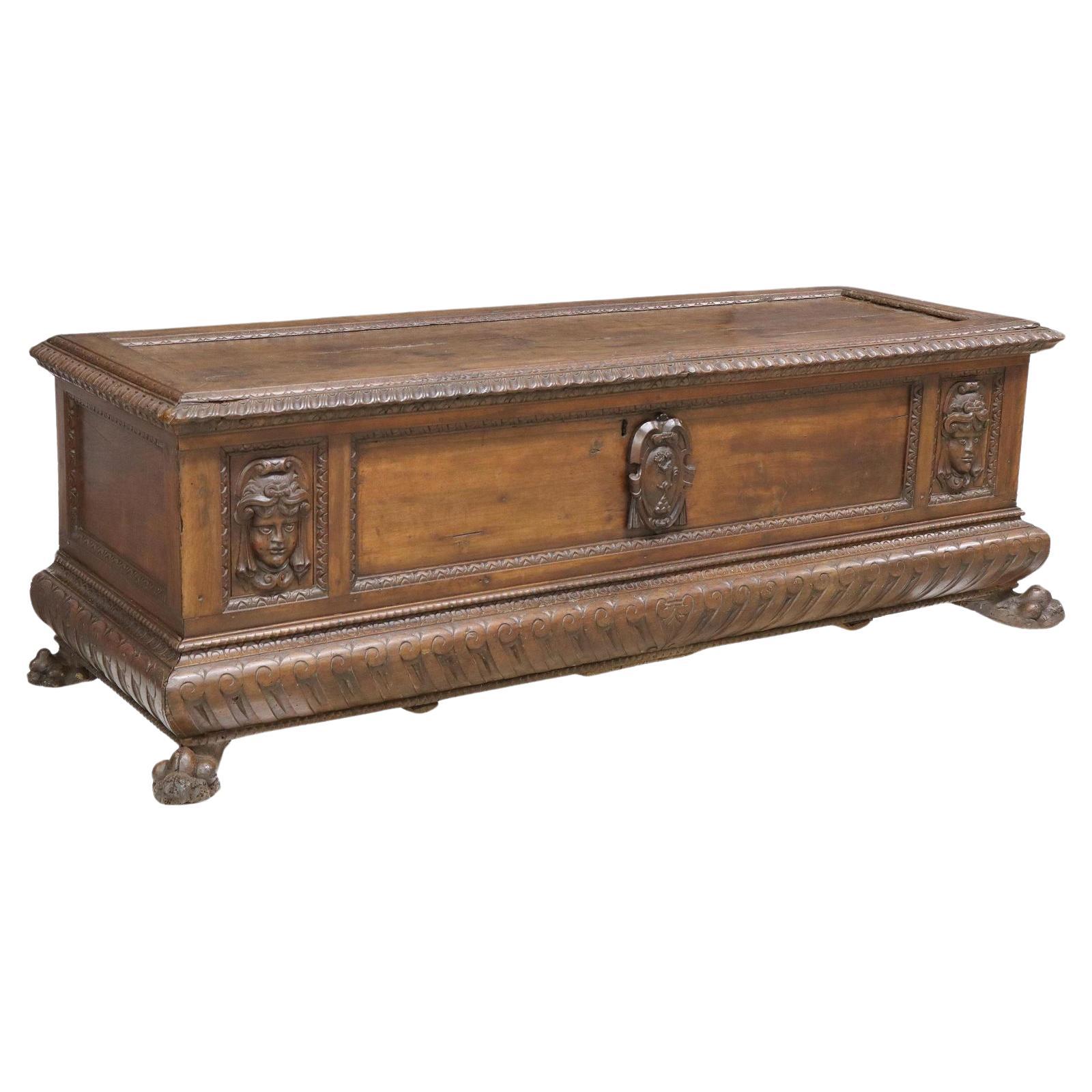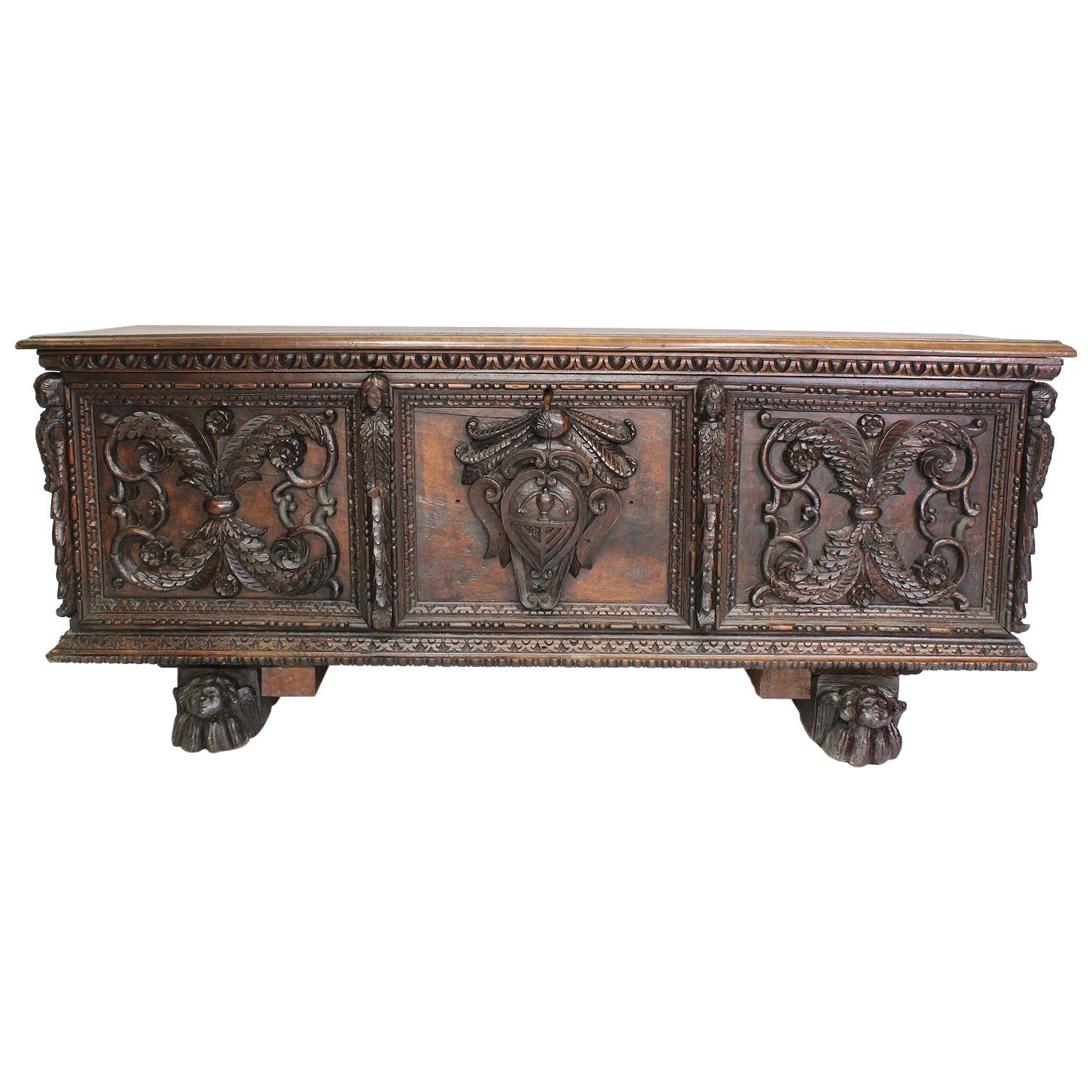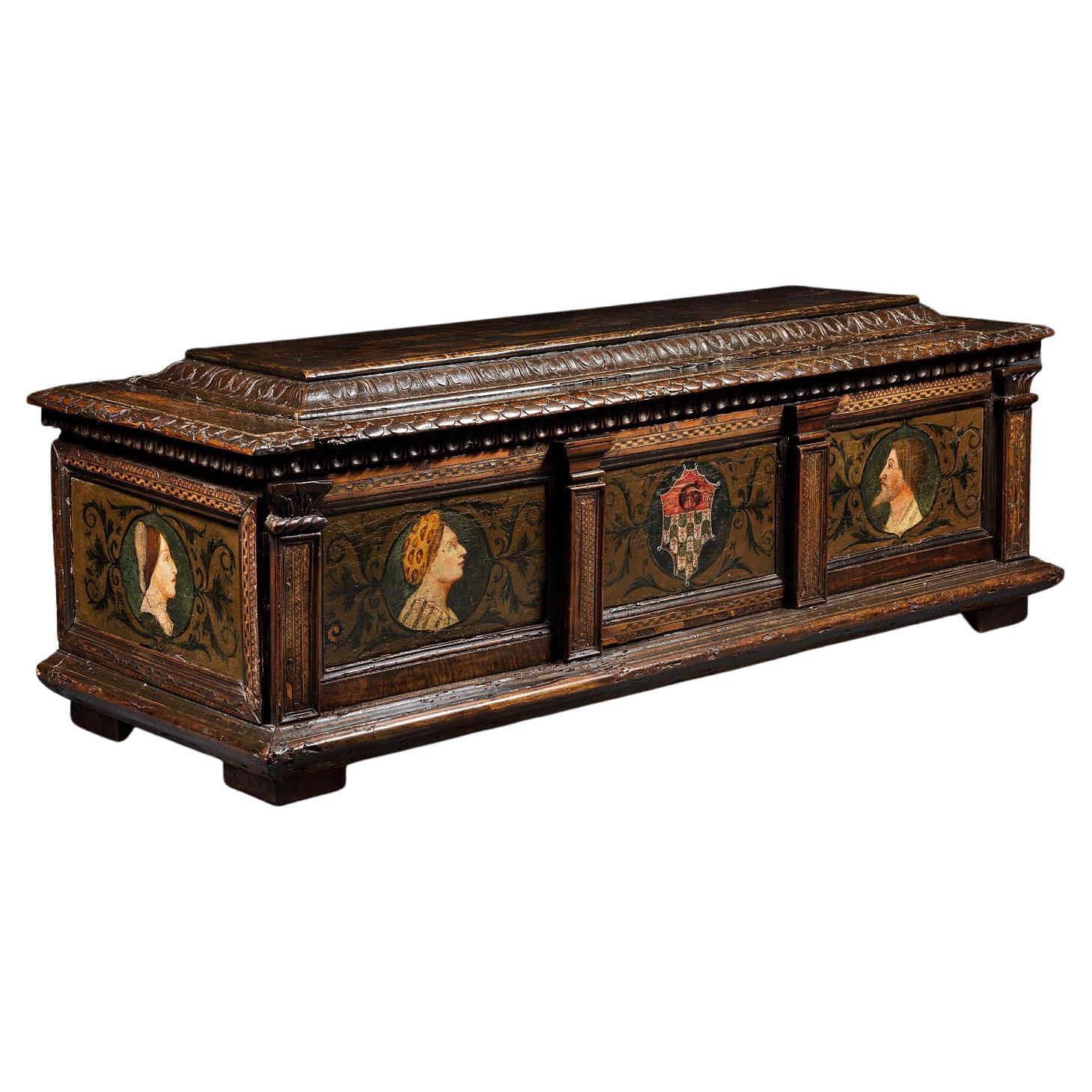Items Similar to Italian Renaissance, Carved Hall Bench, Cassone, Walnut, Italy, 19th Century
Want more images or videos?
Request additional images or videos from the seller
1 of 14
Italian Renaissance, Carved Hall Bench, Cassone, Walnut, Italy, 19th Century
About the Item
Italian Renaissance, Carved Hall Bench, Cassone, Walnut, Italy, 19th Century
A wonderfully carved Hall Bench or Truck, Linen Chest. The whole carved with grapes and pears hanging on the vine. Each level has scalloped carved edges. The top flips open leading to a large storage space for blankets or other items. Fit with a custom cushion.
Height 30 Inches, Depth 27 Inches, Width 57 Inches,
Seat Height 17.5 Inches.
- Dimensions:Height: 30 in (76.2 cm)Width: 57 in (144.78 cm)Depth: 27 in (68.58 cm)
- Style:Renaissance (In the Style Of)
- Materials and Techniques:
- Place of Origin:
- Period:
- Date of Manufacture:1880
- Condition:Wear consistent with age and use. Minor fading. Good original. Slight imperfections, scratches.
- Seller Location:Stamford, CT
- Reference Number:
About the Seller
4.9
Platinum Seller
These expertly vetted sellers are 1stDibs' most experienced sellers and are rated highest by our customers.
Established in 1975
1stDibs seller since 2009
1,597 sales on 1stDibs
Typical response time: <1 hour
- ShippingRetrieving quote...Ships From: Stamford, CT
- Return PolicyA return for this item may be initiated within 1 day of delivery.
More From This SellerView All
- Italian Renaissance Arm / Office Chair, Carved, Leather Seat, 19th CenturyLocated in Stamford, CTItalian Renaissance Arm / Office Chair, Carved, Leather Seat, 19th Century A finely carved example having a worn, in good condition, leather seating a...Category
Antique Early 1900s Italian Renaissance Armchairs
MaterialsLeather, Wood
- Set of 8 19th Century Italian Renaissance Revival Carved Dining ChairsLocated in Stamford, CTA set of eight finely carved and gilt dining chairs, all finely distress paint decorative with original horsehair seats. Each alternating chair measures 18 in W, 43 in H, 15 in D. wi...Category
Antique Early 19th Century Italian Baroque Dining Room Chairs
MaterialsWood, Giltwood
- Renaissance Carved Dining Center Table, Dolphin Claw Foot Base, 19th CenturyLocated in Stamford, CTRenaissance Carved Dining, Center Table, Dolphin Claw Foot Base, 19th Century A finely carved Renaissance Revival Heavily carved dining, center or library table. The scalloped edge table...Category
Early 20th Century Center Tables
MaterialsWood
- Pierre Jeanneret, French Mid-Century Modern Storage Chest, Teak, ChandigarhBy Pierre JeanneretLocated in Stamford, CTPierre Jeanneret, French Mid-Century Modern, Dirty Linen Basket, Cane, Teak, Chandigarh, India c. 1960s This item is directly from Chandigarh, India and has markings indicating prov...Category
Vintage 1960s Indian Mid-Century Modern Blanket Chests
MaterialsCane, Teak
- Pierre Jeanneret, French Mid-Century Modern Storage Chest, Teak, ChandigarhBy Pierre JeanneretLocated in Stamford, CTPierre Jeanneret, French Mid-Century Modern, Dirty Linen Basket, Cane, Teak, Chandigarh, India c. 1960s Rare 'Dirty Linen' box designed by Pierre Jeanneret for Chandigarh, India. Th...Category
Vintage 1960s Indian Mid-Century Modern Blanket Chests
MaterialsCane, Teak
- Pair of Italian 19th Century Baroque Carved Arm Throne Chairs, Figural CarvingsLocated in Stamford, CTPair of Italian 19th century Baroque carved arm throne chairs. The pair with figural carvings and putti sleeping on beds of leafs, attributed to Valentino Panciera Besarel (Venice, 1829-1902) in the manner of Andrea Brustolon (1662-1732). The ornately carved thrones, each flanked with figures of standing males supporting a branch-carved armrests with vines. Raised on cabriolet scrolled legs. Andrea Brustolon (20 July 1662–25 October 1732) was an Italian sculptor in wood. He is known for his furnishings in the Baroque style and devotional sculptures. Biography He was trained in a vigorous local tradition of sculpture in his native Belluno, in the Venetian terraferma, and in the studio of the Genoese sculptor Filippo Parodi, who was carrying out commissions at Padua and at Venice (1677). He spent the years 1678-1680 at Rome, where the High Baroque sculpture of Bernini and his contemporaries polished his style. Apart from that, the first phase of Brustolon's working career was spent in Venice, 1680–1685. Brustolon is documented at several Venetian churches where he executed decorative carving in such profusion that he must have quickly assembled a large studio of assistants. As with his contemporary in London, Grinling Gibbons almost all the high quality robust Baroque carving in Venice has been attributed to Brustolon at one time or another. In the Venetian Ghetto, at the Scola Levantina, Brustolon provided the woodwork for the synagogue on the piano nobile, where the carved, canopied bimah is supported on Solomonic columns, which Brustolon had seen in Bernini's baldacchino in the Basilica of St Peter's. His furniture included armchairs with figural sculptures that take the place of front legs and armrest supports, inspired by his experience of Bernini's Cathedra Petri. The gueridon, a tall Stand for a candelabrum, offered Brustolon unhampered possibilities for variations of the idea of a caryatid or atlas: the familiar Baroque painted and ebonized figural gueridons, endlessly reproduced since the 18th century, found their models in Brustolon's work. His secular commissions from Pietro Venier, of the Venier di San Vio family (a suite of forty sculptural pieces that can be seen in the Sala di Brustolon of the Ca' Rezzonico, Venice), from the Pisani of Strà, and from the Correr di San Simeone families encourage the attribution to him of some extravagantly rich undocumented moveable furniture. Andrea Brustolon's elaborate carved furniture aspired towards the condition of sculpture, such as the Dutch bases for console tables which look like enlargements of the work of the two Van Vianens, Paulus and Adam, perhaps the greatest Dutch silversmiths of the period. These carved pieces display the Baroque tendency to develop a form three-dimensionally in space. Brustolon's walnut, boxwood and ebony pieces transcend ordinary functional limitations of furniture; they are constructed of elaborately carved figures. The framework of Brustolon's chairs, side tables and gueridons were carved as gnarled tree branches, with further supports of putti and male figures carved in ebony. Backrests of the chairs, which were never touched in the rigidly upright posture that contemporary etiquette demanded, were carved with allegories of vanity, fire and music, etc. The most extravagant piece delivered for Pietro Venier was a large side table and vase-stand of box and ebony, designed as a single ensemble to display rare imported Japanese porcelain vases. The eclectic allegories include Hercules with the Hydra and Cerberus, males and reclining river-gods (see ref.). For the Correr, less extrovert chairs bear female nudes extended along the armrests. For the Pisani, he carved a suite of twelve chairs (now at the Palazzo Quirinale) with flowers, fruit, leaves and branches to symbolize the twelve months of the year. Work by Brustolon is at the Villa Pisani at Stra. In 1685 Brustolon returned to the house where he was born at Belluno, and from that time devoted himself mainly to tabernacles and devotional sculptures in walnut, boxwood or ivory. His polychromed ivory Corpus from a crucifix is in the Museo Civico di Belluno, which preserves some of Brustolon's preparatory drawings for frames to be carved with putti displaying emblems. A pair of boxwood sculptures, The Sacrifice of Abraham and Jacob Wrestling with the Angel...Category
Antique 1890s Italian Baroque Armchairs
MaterialsWood
You May Also Like
- Spanish Renaissance Carved Walnut Cassone or Trunk, 19th CenturyLocated in Miami, FLThis piece it´s part of a bargueño without legs, this carved walnut pieces you can use like a cassone, trunk or coffee table, 19th century.Category
Antique Late 19th Century Spanish Baroque Blanket Chests
MaterialsWalnut
- Italian Renaissance Walnut CassoneLocated in Essex, MAWith flat hinged top opening to a open compartment. The curved case carved with a crest and figures and various designs. Bracket feet with trefoil form apron. Sold in a Sothebys Euro...Category
Antique Early 1600s Italian Renaissance Blanket Chests
MaterialsWalnut
- Mid 19th Century Large Antique Italian Renaissance Style Walnut Cassone ChestLocated in Sheridan, COLarge Antique Italian Renaissance style walnut cassone/ storage coffer, 18th c. This chest features a rectangular coffered top, with running ornamentation border, opening to storage ...Category
Antique 1850s Italian Renaissance Blanket Chests
MaterialsIron
- Italian early 17th century painted Renaissance CassoneLocated in Troy, NYCharming painted cassone with a lift top, the rounded front decorated with pastoral scenes, nicely worn and muted under the varnish, darkened by age.Category
Antique Early 1600s Italian Renaissance Blanket Chests
MaterialsWood
- Italian 19th Century Baroque Style Carved Walnut Figural Cassone Chest-TrunkLocated in Los Angeles, CAAn Italian 19th century Baroque Revival style carved walnut figural Cassone chest-trunk. The ornately carved chest, also known as a marriage chest, with ...Category
Antique 19th Century Italian Baroque Revival Commodes and Chests of Drawers
MaterialsWrought Iron
- Italian Renaissance Wedding CassoneLocated in Saint-Ouen, FRItalian Renaissance wedding cassone Origin : Northern Italy, Between Milan And Bologne Period : 15th Century Height : 55 cm Width : 156.5 cm D...Category
Antique 15th Century and Earlier Renaissance Blanket Chests
MaterialsWalnut
Recently Viewed
View AllMore Ways To Browse
Mid Century Blanket Box
Antique Store Dallas
Pennsylvania Decorated Dower Chest
Whaling Chest
Denmark Teak Trunk
Cavalier Cedar Lined Chest
Set Of Art Deco Luggage Pair Of Suitcases
German Stollentruhe
Korean Server
Southern Blanket Chest
17 Century Dowry Chest
17th Century Kist
1800 Asian Blanket Chest
20 C Primitive Cabinet
Antique Cherry Wood Chest Trunk
Antique Wooden Crate Storage Box With Lid
Berks County Chest
Burmese Actors Chest





